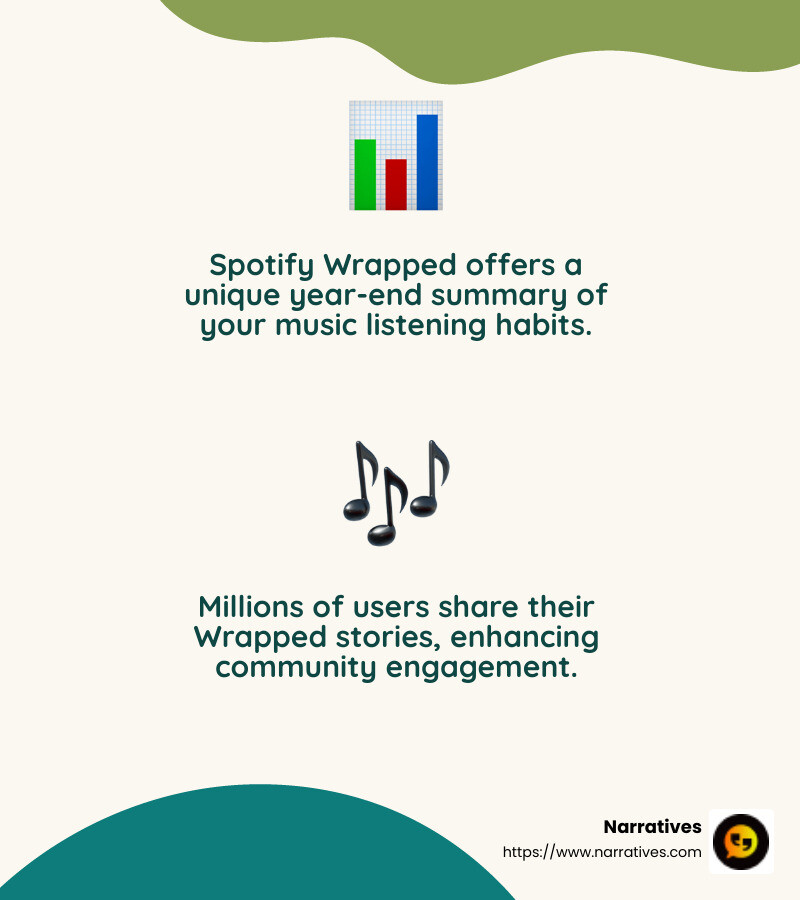Storytelling in the Digital Age: Interactive Examples to Inspire

Interactive digital storytelling examples are changing the way organizations connect with their audiences by creating immersive content that captivates and engages. Some popular techniques include:
- Scrollytelling: Seamlessly combines scroll-triggered animations and audio for a cinematic experience.
- Animations: Adds movement to stories, keeping reader attention and highlighting key points.
- Interactions: Allows for user participation through clickable and hover effects, enhancing engagement.
- Audio: Incorporates sound to enrich the sensory experience and provide interactive feedback.
Storytelling transcends traditional boundaries, embracing visually dynamic and interactive elements. As more brands and nonprofits harness these innovative techniques, they can open up new avenues for advocacy and community engagement.
Digital storytelling, with its fusion of visuals, narratives, and technology, has revolutionized not just journalism but also the way brands communicate their values and missions. This evolution is driven by the goal of creating content that resonates emotionally and leaves a lasting impact.
By blending storytelling artistry with cutting-edge design techniques, organizations can foster deeper connections and provoke meaningful actions. This is vital for non-profits and purpose-driven brands eager to amplify their missions while addressing social and environmental challenges.
Successful digital storytelling bridges the gap between content creation and audience engagement, offering both depth and accessibility.

Handy interactive digital storytelling examples terms:
- interactive storytelling software
- digital storytelling examples for students
- digital storytelling online
What is Digital Storytelling?
Digital storytelling is a modern approach to narrating stories using a mix of digital media like videos, audio, images, and interactive elements. This method allows storytellers to create engaging and immersive experiences that captivate audiences beyond traditional text and images.
Interactive Content
Interactive content is at the heart of digital storytelling. It allows audiences to engage directly with the story, making the experience dynamic and participatory. Examples include:
Scrollytelling: Offers a seamless narrative flow through scroll-triggered animations and effects. This technique creates a cinematic storytelling experience, drawing readers deeper into the narrative as they interact with the content.
Interactive Websites: These platforms allow users to explore stories at their own pace, often incorporating quizzes, maps, and other interactive elements. For instance, the interactive web documentary Bear71 blends emotional storytelling with technology and nature, enabling users to follow a bear's journey in the wild.
Multimedia Tools
The use of multimedia tools is essential in digital storytelling, as they provide the means to combine different media types into a cohesive story. Some popular tools include:
Video and Audio: These elements add depth and emotion to stories, making them more relatable and memorable. Sound can create ambiance and offer feedback during interactions, enhancing the overall experience.
Animations: They bring stories to life by adding movement, which helps maintain reader attention and emphasize important points. For example, animations can make text slide into place or images spin across the screen.
Storytelling Techniques
Effective digital storytelling employs various techniques to ensure the narrative is engaging and impactful. These include:
Personalization: Tailoring the story to the user's preferences or data. Spotify's Wrapped campaign is a prime example, using data storytelling to celebrate each user's unique music tastes, fostering a sense of belonging and community.
Gamification: Incorporating game-like elements into stories can increase engagement and motivation. The Waiting Games at Schiphol Airport use QR codes to create a playful experience for travelers, turning waiting time into an interactive trip.
By leveraging these techniques, digital storytelling becomes a powerful tool for brands and organizations to connect with their audiences. It not only improves engagement but also builds emotional connections, making stories more memorable and effective.
Interactive Digital Storytelling Examples
Interactive digital storytelling is changing the way we connect with audiences, creating immersive experiences that engage and inspire. Let's explore some standout digital storytelling examples that showcase the power of interactive content.
AirBnB - Community Storytelling
AirBnB has mastered the art of community engagement through authentic stories shared by hosts and guests. By highlighting personal experiences and unique cultural insights, AirBnB fosters a sense of connection and belonging. These stories are not just about travel; they are about building a global community through shared narratives.
Bear71 - Interactive Web Documentary
Bear71 is a remarkable interactive web documentary that blends emotional storytelling with themes of technology and nature. It follows a grizzly bear's journey in the wild, offering a poignant look at the impact of human activity on wildlife. This project uses interactive maps and multimedia elements to immerse users in the bear's world, making it a powerful example of how storytelling can evoke empathy and awareness.

Spotify - Wrapped
Spotify's Wrapped campaign is a brilliant use of personalized experiences and data storytelling. By analyzing users' listening habits, Spotify creates a unique year-end summary for each user. This personalized narrative not only celebrates individual musical tastes but also encourages users to share their stories, amplifying brand reach and fostering a sense of community.

The Deep Sea by Neal Agarwal
The Deep Sea is an interactive website that takes users on an educational journey into the ocean's depths. Designed by Neal Agarwal, this project combines storytelling with education, offering fascinating facts about marine life as users scroll deeper into the ocean. It's a simple yet effective way to engage audiences and promote learning through interactive exploration.
Schiphol Airport - The Waiting Games
At Schiphol Airport, waiting is transformed into a playful trip through gamification. The Waiting Games use QR codes to offer travelers interactive challenges and games. This innovative approach turns idle time into an engaging experience, enhancing customer satisfaction and making the airport experience more enjoyable.

These interactive digital storytelling examples highlight the diverse ways brands and organizations can connect with their audiences. By leveraging authentic stories, emotional narratives, personalized experiences, and interactive elements, storytellers can create memorable and impactful experiences that resonate with users.
Benefits of Interactive Digital Storytelling
Interactive digital storytelling is more than just a buzzword. It's a powerful tool that offers numerous benefits for brands and organizations. Let's dig into how it improves engagement, boosts brand awareness, and fosters an emotional connection with audiences.
Engagement
When attention spans are shrinking, keeping your audience engaged is crucial. Interactive digital storytelling does just that by involving users directly in the narrative. By using elements like clickable links, quizzes, and animations, stories become more than just content to consume—they become experiences to participate in. For example, Schiphol Airport's The Waiting Games uses QR codes to turn waiting time into a fun activity, keeping travelers entertained and engaged.
Brand Awareness
Building brand awareness is about being memorable and relatable. Interactive storytelling can help achieve this by creating unique and shareable experiences. Take Spotify's Wrapped campaign, for instance. By offering personalized insights into users' listening habits, Spotify not only celebrates individual tastes but also encourages users to share their stories. This amplifies the brand's reach organically, turning users into brand ambassadors.
Emotional Connection
Stories have the power to evoke emotions, and when they're interactive, that power multiplies. Emotional connections are built when audiences feel a part of the story. Bear71, an interactive web documentary, uses the journey of a grizzly bear to highlight the impact of human activity on wildlife. By immersing users in the bear's world, it evokes empathy and raises awareness about environmental issues. This emotional engagement makes the story—and the message—stick.
Incorporating these elements into your storytelling strategy can transform how audiences perceive and interact with your brand. By focusing on engagement, brand awareness, and emotional connection, interactive digital storytelling can create lasting impressions that drive action and loyalty.
How to Implement Interactive Digital Storytelling
Implementing interactive digital storytelling is like crafting an engaging conversation with your audience. To make it effective, focus on three essential steps: understanding your audience, integrating multimedia, and selecting the right platform.
Audience Understanding
Before creating any story, it's crucial to know who you're talking to. Start by identifying your audience's interests, needs, and pain points. What problems are they trying to solve? What makes them tick? By answering these questions, you can tailor your story to resonate with them.
For instance, AirBnB's community storytelling thrives on understanding its diverse audience. By sharing authentic stories from guests and hosts, AirBnB connects on a personal level, making everyone feel like they belong anywhere.
Multimedia Integration
Once you know your audience, it's time to decide how to tell your story. Interactive digital storytelling thrives on multimedia elements like videos, images, text, and audio. Combining these elements can create a rich, immersive experience.
Consider The Deep Sea by Neal Agarwal. This interactive website uses scrolling to take users on an educational journey through ocean life. By integrating simple animations and facts, Neal turns a static subject into an engaging exploration.
Think about how you can use different media to bring your story to life. Videos can show action, images can capture moments, and text can provide context. The key is to create a seamless blend that improves your narrative.
Platform Selection
Finally, choosing the right platform is essential for reaching your audience effectively. Different platforms offer varying capabilities and reach, so it's important to pick one that aligns with your goals.
For example, Schiphol Airport's The Waiting Games uses QR codes to engage travelers at the airport. This choice of platform ensures the story reaches the right audience—people who have time to spare and are looking for entertainment.
When selecting a platform, consider where your audience spends their time. Is it on social media, a dedicated website, or perhaps a mobile app? Choose a platform that complements your story and makes it accessible to your target audience.
By focusing on audience understanding, multimedia integration, and platform selection, you can create interactive digital stories that captivate and connect. These steps will help you craft experiences that not only engage but also inspire action and build lasting relationships with your audience.
Frequently Asked Questions about Interactive Digital Storytelling
What are the key elements of a good digital story?
Creating a compelling digital story hinges on a few key elements. First, a clear message is essential. Your audience should immediately understand the core idea you're communicating. This message should be concise and resonate with the audience's values or needs.
Next, focus on compelling content. Use a mix of text, images, videos, and audio to create an engaging narrative. The content should not only inform but also captivate the audience. Think of it as a way to keep them glued to your story, much like a page-turner novel.
Lastly, a story must be audience-centered. Tailor your narrative to the interests and preferences of your audience. A great example is the use of "The Hero's Journey" technique, which places the audience in the shoes of the protagonist, making the story more relatable and impactful.
How can non-profits benefit from digital storytelling?
Non-profits can harness the power of digital storytelling to create significant social impact. By sharing stories that highlight their mission and the communities they serve, they can foster a deeper connection with supporters and potential donors.
Community-driven storytelling is particularly effective. By featuring real stories from the people they help, non-profits can showcase the tangible difference they make. This approach not only humanizes their cause but also builds trust and credibility.
Digital storytelling also provides increased visibility. By leveraging various digital platforms, non-profits can broaden their reach and engage with a global audience. This increased visibility can lead to more support, both in terms of donations and volunteer involvement.
What tools are available for creating interactive digital stories?
Creating interactive digital stories is easier than ever with a range of multimedia tools and storytelling platforms at your disposal. These tools allow you to blend text, images, video, and audio seamlessly, crafting an immersive experience for your audience.
Platforms like Apester and Storify offer features such as interactive videos and social media integration, enabling you to engage your audience in new ways. These platforms often come with user-friendly interfaces, making it accessible even for those with limited technical skills.
Additionally, professional no-code design software is becoming more popular, allowing creators to build interactive stories without extensive coding knowledge. These tools empower storytellers to focus on creativity and message, rather than technical problems.
By utilizing these tools and platforms, you can create interactive digital stories that not only tell a compelling narrative but also invite your audience to participate and engage.
Conclusion
Storytelling has evolved into a powerful tool for driving social impact, especially for non-profits. At Narratives, we understand the unique challenges faced by purpose-driven organizations and are committed to helping them amplify their voices through interactive digital storytelling.
Our focus is on non-profit partnerships that lift underrepresented voices and showcase the real-world impact of their work. By crafting high-quality, emotionally resonant multimedia content, we help non-profits share their stories in a way that not only informs but also inspires action. This approach builds trust and increases visibility, crucial for attracting support and driving meaningful change.
Digital storytelling offers a unique opportunity to connect with audiences on a deeper level. Through community-driven storytelling, non-profits can highlight the stories of those they serve, creating a ripple effect of empathy and support. This method not only humanizes the cause but also fosters a sense of community and shared purpose.
In today's digital landscape, standing out is more important than ever. By embracing interactive storytelling, non-profits can engage their audiences in innovative ways, turning passive viewers into active participants. This engagement is key to building long-lasting relationships and achieving sustainable social impact.
As we look to the future, the potential for digital storytelling to transform the way non-profits communicate their mission is immense. By leveraging the right tools and techniques, organizations can craft narratives that resonate, inspire, and drive action. At Narratives, we're excited to be part of this journey, supporting non-profits as they harness the power of storytelling to make a difference in the world.


